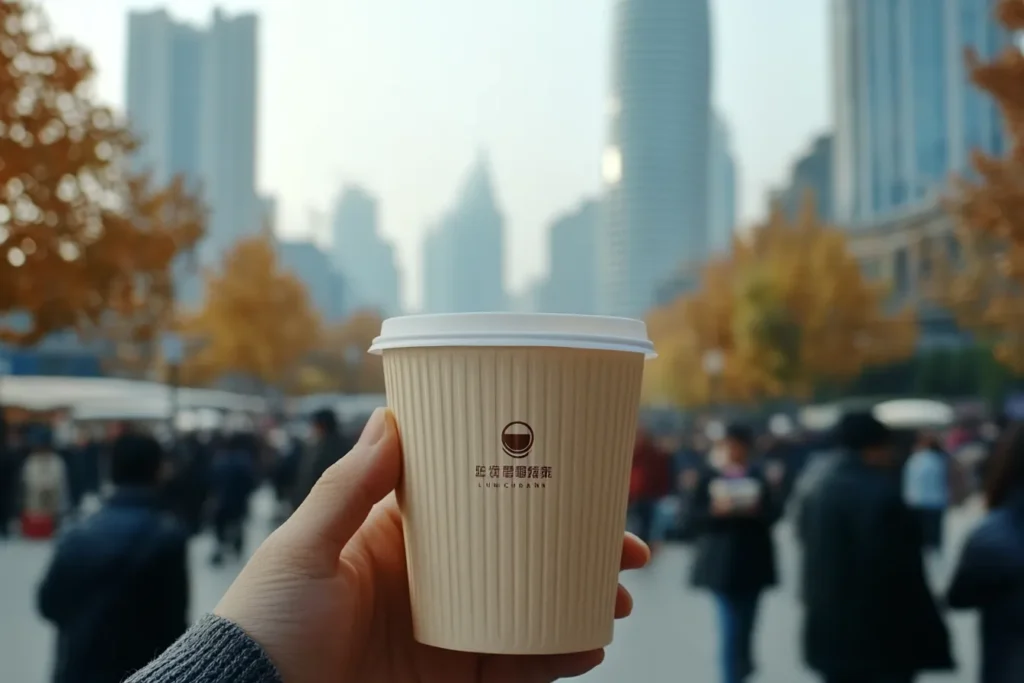Introduction
In recent years, few brands have captured China’s imagination quite like Luckin Coffee. With its rapid expansion, technology-driven ordering system, and affordable menu, Luckin Coffee has challenged the global coffee giant Starbucks and rewritten the rules of the Chinese café market. What started as a scrappy upstart in 2017 quickly evolved into one of the largest coffee chains in China. Despite facing a massive accounting scandal in 2020, Luckin Coffee emerged from the ashes stronger, leaner, and even more ambitious.
In this in-depth blog post, we’ll explore how Luckin Coffee revolutionized China’s coffee culture, the unique strategies that fueled its meteoric rise, its challenges, and its plans for the future. Whether you’re a coffee lover, a business enthusiast, or simply curious about the next big thing in global coffee, this article will break down everything you need to know about Luckin Coffee’s journey..Best Iced Tea Recipe
The Rise of Luckin Coffee
Founding and Early Growth
Luckin Coffee was founded in 2017 by Jenny Qian Zhiya and Charles Zhengyao Lu, two Chinese entrepreneurs with a bold vision: make premium coffee affordable and convenient to every Chinese consumer. At the time, Starbucks dominated China’s coffee landscape, but its prices and café-centered business model limited access to a relatively small, affluent segment of the population.
Luckin’s founders saw an opportunity. They launched an app-based coffee-ordering system that prioritized takeaway and delivery, cutting down operational costs tied to in-store seating and décor. With an aggressive marketing push, including free coupons and discounts, they acquired customers at lightning speed. By late 2018, Luckin had already opened over 2,000 stores — a growth rate unprecedented in the global coffee industry.
Disruptive Business Model
At the core of Luckin Coffee’s early success was its disruptive business model. Instead of relying on a premium sit-down café experience like Starbucks, Luckin targeted China’s fast-paced urban consumers with a “grab-and-go” and delivery-first approach. Their outlets were designed for efficiency rather than ambiance, and many operated as small pickup stations.
Furthermore, Luckin invested heavily in digital integration. Every order had to go through the Luckin app, creating a data-rich ecosystem to analyze consumer preferences, optimize inventory, and reduce waste. This strategy made their operations lean and scalable, allowing them to roll out thousands of new stores in record time.
The company also took advantage of China’s growing e-payment culture, encouraging customers to pay through the app seamlessly, skipping cash entirely. This made the ordering process incredibly fast and consistent, whether the customer was ordering a latte or a seasonal cold brew.

What Makes Luckin Coffee Different?
Luckin Coffee didn’t just bring another café concept to the Chinese market — it created an entirely new blueprint for coffee retail in China. By focusing on affordability, technology, and consumer-centric innovation, Luckin transformed coffee from a luxury lifestyle product to a convenient, everyday habit for millions of Chinese customers. Let’s explore exactly what sets Luckin apart from both its local and international competitors.
Technology-Driven Operations
One of the strongest pillars of Luckin Coffee’s success is its seamless use of technology. Unlike traditional coffee chains, Luckin prioritized a 100% digital ordering model from the start. Customers download the Luckin app, place their order, pay digitally, and then pick up their drinks at a nearby store or have them delivered. This streamlined, contactless model turned out to be perfect for China’s urban, tech-savvy population, especially during the COVID-19 pandemic when social distancing was a priority.
By integrating all sales and operations through the app, Luckin gained deep insights into its customers’ preferences, shopping behaviors, and seasonal trends. This data-driven approach enabled them to adjust menus, test new products, and optimize inventory far faster than legacy competitors. The technology also created operational efficiencies that cut down labor costs and improved consistency, helping them deliver a better customer experience at scale..Strawberry Lemonade
Affordable Pricing Strategy
Starbucks had long been considered a symbol of premium status in China, but its prices were too steep for many middle-class consumers to drink coffee daily. Luckin turned this narrative on its head by offering barista-quality drinks at prices 20%–30% lower than Starbucks, using aggressive promotions and coupons to attract trial customers.
They achieved this affordability by running minimalist pick-up stores rather than expensive sit-down cafés, using local supply chains, and investing heavily in automation to reduce staffing needs. This value-driven pricing strategy resonated powerfully with younger Chinese consumers who wanted high-quality coffee without the luxury price tag.
Moreover, Luckin frequently introduced “buy one, get one” promotions and loyalty deals through its app, further lowering the perceived cost of coffee. These promotions made daily coffee drinking a feasible habit rather than an occasional treat, dramatically expanding the coffee-drinking population in China.
Menu Innovation
Luckin Coffee is also known for constantly refreshing its menu with new drinks and seasonal specials, giving customers reasons to come back. From innovative milk teas to fruit-infused cold brews and even plant-based beverages, Luckin was quick to adapt to evolving tastes..Brazilian Mounjaro Recipe
For example, its popular “Cheese Latte,” which combines espresso with a layer of creamy cheese foam, created a viral sensation on Chinese social media, helping Luckin stand out in an increasingly crowded market. Their seasonal offerings, often featuring trendy flavors like coconut or taro, also keep the menu lively and help the brand stay relevant among younger audiences who crave novelty and fun.
By staying close to its customers and using data-driven insights to test and refine products, Luckin has built a menu that feels both familiar and exciting, striking the perfect balance for China’s evolving coffee culture.
Luckin Coffee’s Impact on China’s Coffee Culture
China’s relationship with coffee has long been overshadowed by its ancient tea traditions. Yet in the past decade, this has changed dramatically — and Luckin Coffee has been one of the main catalysts. By offering affordable, high-quality, and accessible coffee, Luckin introduced millions of people to coffee drinking as a daily ritual rather than a rare luxury. Let’s break down exactly how this impact has reshaped China’s modern beverage culture.
Changing Consumption Habits
Before Luckin entered the scene, coffee consumption in China was mostly concentrated among affluent, white-collar professionals, usually within large cities like Shanghai and Beijing. Starbucks had created a sense of premium lifestyle around coffee, but it was largely a sit-down experience, with a relatively high price tag and slower growth outside first-tier cities.
Luckin changed the game by democratizing coffee. Its lower pricing, focus on takeout and delivery, and massive digital reach brought coffee to younger, more budget-conscious consumers in second- and third-tier cities. Suddenly, grabbing a latte on the way to work or ordering a cold brew with friends became part of a broader lifestyle for millions who had never thought of coffee as part of their daily routine.
Furthermore, Luckin’s fast, app-based ordering system perfectly matched the habits of China’s mobile-first society. With smartphones practically glued to people’s hands, ordering a fresh cup of coffee became as easy and familiar as ordering lunch from a food delivery app. As a result, coffee culture in China shifted from “occasional luxury” to “daily essential” for a much larger segment of the population.
Competing with Starbucks
Luckin Coffee’s rise created serious competition for Starbucks, which had enjoyed a near-monopoly on premium coffee in China. While Starbucks focused on premium branding and high-end café experiences, Luckin challenged it with price, speed, and digital convenience.
Starbucks still holds a powerful position thanks to its strong brand image and loyal customer base, but Luckin’s presence forced it to innovate as well. For example, Starbucks rolled out more digital features, launched its own delivery partnership with Alibaba’s Ele.me, and adapted to smaller, faster store formats in response to Luckin’s aggressive model.
There’s no doubt that the rivalry has benefited Chinese consumers. With two big players pushing each other to offer better service, more variety, and more competitive prices, China’s coffee drinkers now enjoy more choices than ever before. This dynamic competition has created a more mature, thriving coffee market, where innovation and consumer focus are the new normal.
Luckin Coffee’s impact on consumption habits goes beyond just coffee. It has inspired other beverage brands — including tea chains and juice shops — to explore digital ordering, smaller store footprints, and lower pricing strategies. In this sense, Luckin’s influence reaches far beyond coffee, shaping how Chinese consumers approach all kinds of drinks today.

Challenges Faced by Luckin Coffee
While Luckin Coffee’s growth story is remarkable, it hasn’t been smooth sailing. In fact, the brand faced one of the most dramatic corporate scandals in China’s recent history. For all its innovation and customer-focused strategy, Luckin found itself in deep trouble in 2020 when a massive accounting fraud came to light. Despite this, the company has made an incredible comeback — but it hasn’t been easy. Let’s unpack these challenges and how Luckin managed to rebuild its reputation.
Accounting Scandal and Its Aftermath
In April 2020, Luckin Coffee publicly admitted that it had fabricated approximately $310 million worth of sales, sending shockwaves through the global investment community. This revelation caused the company’s stock to plummet on the Nasdaq, and it was eventually delisted from the exchange. Senior executives were fired, including CEO Jenny Qian Zhiya, and Luckin faced intense scrutiny from Chinese regulators and the global business community.
For a brand that prided itself on being tech-driven and transparent, the fraud exposed deep flaws in its corporate governance and internal controls. It was a moment of reckoning, not only for Luckin but for investors in the booming Chinese tech sector. Many questioned whether Luckin could survive at all after such a dramatic collapse in trust.
Yet, in an unexpected twist, Luckin refused to disappear. The company filed for Chapter 15 bankruptcy protection in the United States, restructured its debts, and reorganized its management team. Through these painful reforms, Luckin found a way to stay afloat, keep its stores open, and continue serving customers across China.
Regaining Consumer Trust
Emerging from such a high-profile scandal would have been impossible for many brands. But Luckin Coffee had a critical advantage: loyal customers who still loved the product. Many consumers were more interested in the brand’s affordable, convenient coffee than its corporate drama. This gave Luckin a unique opportunity to rebuild.
The new leadership doubled down on corporate governance reforms, improving transparency and tightening financial oversight. Luckin also slowed its pace of store expansion to focus on sustainable growth rather than breakneck scaling. The brand continued investing in its app ecosystem, introducing loyalty programs and seasonal campaigns to keep customers engaged.
Crucially, Luckin’s focus on product quality and consistent service helped stabilize its reputation. By continuing to deliver value and convenience, the brand regained the confidence of everyday coffee drinkers even as it worked to settle legal and financial challenges in the background.
In 2022, Luckin announced it had successfully completed its bankruptcy restructuring and was profitable again — a major milestone that few could have predicted during the height of the scandal. This remarkable turnaround demonstrated that even in a market as competitive and fast-moving as China’s, a brand can bounce back if it listens to its customers and fixes its mistakes.

Future Outlook for Luckin Coffee
Having survived one of the most dramatic scandals in corporate history, Luckin Coffee has now repositioned itself for the future with renewed confidence and focus. Its rebound proves that there is still enormous potential for growth in China’s evolving coffee market, as well as opportunities beyond its borders. Let’s explore what the future might look like for this ambitious coffee chain.
Expansion Plans in China and Abroad
After restructuring, Luckin Coffee turned its sights back to what it does best: rapid, strategic expansion. As of 2024, the brand has already surpassed 12,000 stores across China, making it one of the country’s largest coffee networks. But Luckin isn’t stopping there. Its strategy now includes penetrating smaller cities and rural areas where coffee culture is still developing, helping introduce affordable premium coffee to a brand-new audience.
Beyond China, industry insiders speculate that Luckin will eventually test international waters again. Although it had put global plans on hold during its scandal recovery, the brand’s efficient, data-driven, app-based model could easily adapt to markets with similar urban, tech-savvy populations — for instance, Southeast Asia, India, or even the Middle East.
If Luckin carefully applies the lessons learned from its earlier mistakes, its proven low-cost, high-efficiency system could challenge local players in these new markets. However, success abroad will demand strong partnerships, transparent governance, and a tailored approach to local tastes and regulations.
Embracing Sustainability
As modern consumers demand more responsibility from their favorite brands, Luckin Coffee is also moving to embrace sustainability. The company has begun shifting toward more environmentally friendly packaging, introducing reusable cups in select locations, and exploring carbon-neutral operations.
Moreover, Luckin is investing in responsible sourcing of coffee beans, working with suppliers who meet fair-trade and sustainability certifications. In a country where environmental consciousness is growing rapidly among younger generations, these steps are critical for long-term brand loyalty and social acceptance.
Additionally, Luckin’s reliance on technology may support future sustainability efforts. For instance, its data-driven inventory management can help minimize waste, while digital ordering systems cut down on paper receipts and unnecessary packaging. All of these innovations align with China’s national goals for environmental responsibility and position Luckin as a modern, forward-thinking brand.
As Luckin moves forward, its biggest challenge will be balancing aggressive growth with corporate ethics and sustainability. If it can strike that balance, there is no reason Luckin cannot maintain its place as a major force in China’s — and perhaps the world’s — coffee culture.
FAQs
Is Luckin Coffee cheaper than Starbucks?
Yes, generally speaking, Luckin Coffee is about 20–30% cheaper than Starbucks in China. This is thanks to its lower overhead costs, smaller pick-up stores, and a business model built around affordable premium coffee.
Can you order Luckin Coffee overseas?
Currently, Luckin Coffee primarily operates in mainland China. There are no confirmed overseas stores as of now, but industry rumors suggest it might consider expanding internationally in the future.
What are the most popular Luckin Coffee drinks?
Some of the brand’s top sellers include its Classic Americano, Latte, Cheese Latte (with creamy cheese foam), and various seasonal cold brews and fruit-infused coffees that trend heavily on Chinese social media.
How did Luckin Coffee recover after the scandal?
After its accounting fraud scandal, Luckin replaced its leadership, restructured its debts, improved corporate governance, and doubled down on its data-driven business model. Customers, still loyal to the brand’s convenience and pricing, helped it recover surprisingly quickly.
Does Luckin Coffee offer loyalty rewards?
Yes, Luckin Coffee has an app-based loyalty program with frequent buy-one-get-one promotions, free drinks after a certain number of purchases, and seasonal discounts to encourage repeat customers.
Is Luckin Coffee publicly traded?
Luckin Coffee was delisted from the Nasdaq after the 2020 scandal. Since then, it has undergone bankruptcy restructuring and is currently privately held, although rumors about a possible relisting surface from time to time.
Conclusion
Luckin Coffee’s story is one of incredible highs, staggering lows, and an inspiring recovery. From its bold entrance in 2017 to its accounting scandal and dramatic turnaround, the brand has reshaped how Chinese consumers experience coffee. Its technology-driven, affordable, and efficient model made coffee a daily habit for millions of people and forced even the biggest global names to rethink their strategies.
As Luckin looks to the future, balancing rapid growth with transparency and sustainability will be crucial. If it can stay true to its mission of making premium coffee accessible and convenient for everyone, there’s no doubt Luckin Coffee will remain a dominant force in China — and maybe one day, worldwide.

Name: Luckin Coffee Style Iced Latte
Ingredients
Equipment
Method
- Instructions:
- Brew two shots of espresso using your machine or strong coffee maker.
- Fill a tall glass with ice cubes.
- Pour the freshly brewed espresso over the ice.
- Add chilled milk over the espresso and stir gently.
- Sweeten with syrup if desired.
- Serve immediately and enjoy!

